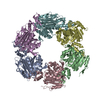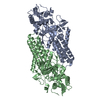+Search query
-Structure paper
| Title | An atlas of protein homo-oligomerization across domains of life. |
|---|---|
| Journal, issue, pages | Cell, Vol. 187, Issue 4, Page 999-1010.e15, Year 2024 |
| Publish date | Feb 15, 2024 |
 Authors Authors | Hugo Schweke / Martin Pacesa / Tal Levin / Casper A Goverde / Prasun Kumar / Yoan Duhoo / Lars J Dornfeld / Benjamin Dubreuil / Sandrine Georgeon / Sergey Ovchinnikov / Derek N Woolfson / Bruno E Correia / Sucharita Dey / Emmanuel D Levy /      |
| PubMed Abstract | Protein structures are essential to understanding cellular processes in molecular detail. While advances in artificial intelligence revealed the tertiary structure of proteins at scale, their ...Protein structures are essential to understanding cellular processes in molecular detail. While advances in artificial intelligence revealed the tertiary structure of proteins at scale, their quaternary structure remains mostly unknown. We devise a scalable strategy based on AlphaFold2 to predict homo-oligomeric assemblies across four proteomes spanning the tree of life. Our results suggest that approximately 45% of an archaeal proteome and a bacterial proteome and 20% of two eukaryotic proteomes form homomers. Our predictions accurately capture protein homo-oligomerization, recapitulate megadalton complexes, and unveil hundreds of homo-oligomer types, including three confirmed experimentally by structure determination. Integrating these datasets with omics information suggests that a majority of known protein complexes are symmetric. Finally, these datasets provide a structural context for interpreting disease mutations and reveal coiled-coil regions as major enablers of quaternary structure evolution in human. Our strategy is applicable to any organism and provides a comprehensive view of homo-oligomerization in proteomes. |
 External links External links |  Cell / Cell /  PubMed:38325366 PubMed:38325366 |
| Methods | EM (single particle) / X-ray diffraction |
| Resolution | 1.85 - 2.8 Å |
| Structure data | EMDB-17402, PDB-8p49: EMDB-18415, PDB-8qhp:  PDB-8q70: |
| Chemicals |  ChemComp-MG:  ChemComp-CL:  ChemComp-HOH:  ChemComp-ZN: |
| Source |
|
 Keywords Keywords | UNKNOWN FUNCTION / uncharacterized /  hexamer / hexamer /  pyrococcus / pore / pyrococcus / pore /  ISOMERASE / ISOMERASE /  pseudouridine / pseudouridine /  synthase / synthase /  homodimer / homodimer /  tRNA / tRNA /  LIGASE / LIGASE /  cysteine / synthetase / cysteine / synthetase /  RNA RNA |
 Movie
Movie Controller
Controller Structure viewers
Structure viewers About Yorodumi Papers
About Yorodumi Papers









